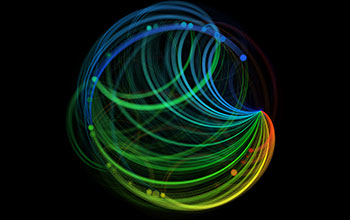Multimedia Gallery
'Connectivity of a Cognitive Computer Based on the Macaque Brain'
"Connectivity of a Cognitive Computer Based on the Macaque Brain," by Emmett McQuinn, Theodore M. Wong, Pallab Datta, Myron D. Flickner, Raghavendra Singh, Steven K. Esser, Rathinakumar Appuswamy, William P. Risk and Dharmendra S. Modha, Cognitive Computing Group, IBM Almaden Research Center.
Inspired by the neural architecture of a macaque brain, this ghostly neon swirl is the wiring diagram for a new kind of computer that, by some definitions, may soon be able to think. Over the past two years, IBM's cognitive computing group in San Jose, California, has made great strides toward designing a computer that can detect patterns, plan responses and learn from its mistakes, says Emmett McQuinn, a hardware engineer at IBM who designed the image.
This image won first place in the illustration category of the 2012 Visualization Challenge, now called the Vizzies, a long-running, annual competition co-sponsored by the National Science Foundation (NSF) and Popular Science magazine. [The competition was formerly named the International Science & Engineering Visualization Challenge (SciVis) and was previously co-sponsored with AAAS' journal Science.] The competition aims to recognize some of the most beautiful visualizations from the worlds of science and engineering and awards prizes in five categories: photography, video, illustration, posters & graphics and interactives.
To learn more about the competition and view all the winning entries, past and present, see the NSF Special Report The VIZZIES: Visualization Challenge. (Date of Image: June 2012)
Credit: Emmett McQuinn, Theodore M. Wong, Pallab Datta, Myron D. Flickner, Raghavendra Singh, Steven K. Esser, Rathinakumar Appuswamy, William P. Risk and Dharmendra S. Modha
Images and other media in the National Science Foundation Multimedia Gallery are available for use in print and electronic material by NSF employees, members of the media, university staff, teachers and the general public. All media in the gallery are intended for personal, educational and nonprofit/non-commercial use only.
Images credited to the National Science Foundation, a federal agency, are in the public domain. The images were created by employees of the United States Government as part of their official duties or prepared by contractors as "works for hire" for NSF. You may freely use NSF-credited images and, at your discretion, credit NSF with a "Courtesy: National Science Foundation" notation.
Additional information about general usage can be found in Conditions.
Also Available:
Download the high-resolution JPG version of the image. (19.7 MB)
Use your mouse to right-click (Mac users may need to Ctrl-click) the link above and choose the option that will save the file or target to your computer.



